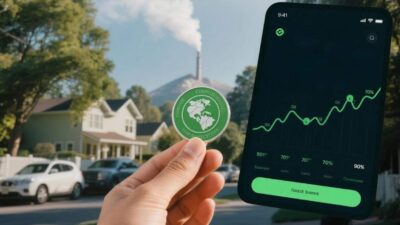Pricing Pollution with Precision in the Climate Race
When Static Taxes Meet Dynamic Reality
The climate crisis is accelerating. Global temperatures have risen 1.1°C since pre-industrial times, and extreme weather events—from wildfires in Canada to floods in Pakistan—are becoming more frequent and severe. To curb emissions, governments rely on tools like carbon taxes, which penalize polluters by taxing their greenhouse gas outputs. Yet, traditional carbon taxes are static: fixed rates applied to broad categories (e.g., $50 per ton of CO₂) regardless of real-time conditions. This rigidity fails to account for fluctuating emissions, regional disparities, or urgent climate events—leaving gaps for free-riders and underpricing critical moments of high pollution.
Enter the global carbon tax algorithm using real-time data: a revolutionary approach that merges machine learning, IoT sensors, and satellite monitoring to dynamically adjust tax rates based on live emissions data. By pricing pollution in real time, this innovation transforms carbon taxes from a blunt instrument into a precision tool, accelerating decarbonization and ensuring fairness. This report explores how it works, its benefits, and the path to scaling it globally.
What Is a Global Carbon Tax Algorithm?
A global carbon tax algorithm is a data-driven system that calculates and adjusts carbon taxes in real time using inputs from:
- IoT Sensors: Deployed in factories, power plants, and vehicles to monitor emissions (e.g., CO₂, methane) minute-by-minute.
- Satellite and Drone Data: Track deforestation, wildfires, and industrial activity to measure emissions from hard-to-monitor sectors (e.g., agriculture, shipping).
- Energy Grid Data: Monitor electricity consumption and fuel sources (e.g., coal vs. renewables) to attribute emissions to specific regions or industries.
- Transportation Data: GPS and vehicle telematics to track fuel use and emissions from cars, ships, and planes.
This data feeds into machine learning (ML) models that analyze trends, predict emissions spikes, and calculate optimal tax rates. The algorithm then adjusts tax levels dynamically—hourly, daily, or weekly—to reflect current conditions, ensuring polluters pay the true cost of their emissions when they occur.
How It Works: From Data to Dynamic Pricing
The algorithm operates in a closed loop, combining data collection, analysis, and action:
1. Real-Time Data Aggregation
Sensors, satellites, and grids continuously collect emissions data. For example:
- A factory’s IoT sensors report CO₂ output every 15 minutes.
- Satellites detect a wildfire in Brazil, estimating methane emissions.
- A city’s energy grid logs a spike in coal-fired power use during a heatwave.
2. ML-Driven Emission Forecasting
Machine learning models process this data to:
- Predict Emissions: Anticipate spikes (e.g., increased energy use during cold snaps) or dips (e.g., solar-powered days).
- Identify Hotspots: Pinpoint regions or industries with unusually high emissions (e.g., a steel mill exceeding permits).
- Calculate Marginal Costs: Determine the social cost of carbon (SCC)—the economic damage caused by each ton of CO₂—adjusted for real-time impacts (e.g., higher healthcare costs during a pollution-related asthma surge).
3. Dynamic Tax Adjustment
Based on forecasts and SCC calculations, the algorithm sets tax rates in real time. For instance:
- During a heatwave, when energy demand (and coal use) surges, the algorithm hikes taxes on fossil fuel generators to discourage overuse.
- In a region with high deforestation, taxes on agricultural exports rise to penalize land-clearing.
- For industries exceeding emission targets, the algorithm imposes “penalty rates” to incentivize rapid reductions.
4. Transparency and Accountability
All data and tax adjustments are recorded on a blockchain, ensuring immutability. Stakeholders (governments, businesses, citizens) can access real-time dashboards to see:
- Which sectors are paying the most.
- How tax revenue is allocated (e.g., to renewable energy subsidies or climate resilience projects).
- The direct impact of tax adjustments on emissions (e.g., “Tax hike reduced factory emissions by 15% in 24 hours”).
Why This Algorithm Transforms Climate Policy
Traditional carbon taxes are like using a sledgehammer to kill a fly: they penalize all emitters equally, regardless of when or how they pollute. The global algorithm, by contrast, is a scalpel—precise, adaptive, and fair. Here’s why it matters:
1. Reduces Free-Riding and Encourages Real-Time Action
Static taxes let polluters delay reductions, knowing they’ll pay the same rate next quarter. Real-time algorithms eliminate this loophole: if a factory spews extra CO₂ today, its tax bill rises today. This incentivizes immediate action—like switching to renewables or optimizing operations—to avoid higher costs.
2. Funds Climate Resilience Equitably
Tax revenue is no longer a vague “pool”—it’s tied to real-time pollution. For example:
- Revenue from a heatwave-induced tax hike on energy could fund emergency cooling centers for vulnerable communities.
- Funds from deforestation-linked taxes could finance reforestation projects in the same region.
This ensures that those most responsible for pollution also fund the solutions.
3. Drives Innovation in Clean Tech
By penalizing high emissions immediately, the algorithm accelerates demand for low-carbon alternatives. For instance:
- A spike in EV charging taxes during peak hours (to reduce grid strain) would push consumers to adopt home batteries or solar.
- High taxes on industrial methane leaks would incentivize companies to invest in leak-detection tech.
4. Addresses Regional and Sectoral Inequities
Traditional taxes often hit low-income regions hardest (e.g., coal-dependent areas). Real-time algorithms can adjust rates to reflect local contexts:
- A rural community reliant on diesel generators might get temporary tax breaks if transitioning to solar, while a wealthy urban area with high transport emissions faces steeper rates.
- Industries with proven decarbonization plans (e.g., steel mills using green hydrogen) could receive tax credits, fostering a “race to the top.”
Challenges and Solutions
While transformative, global carbon tax algorithms face hurdles:
1. Data Privacy and Security
Real-time data collection raises concerns about industrial espionage or misuse of sensitive information (e.g., a factory’s emissions data).
Solution: Use federated learning—train ML models on decentralized data without sharing raw inputs—and enforce strict encryption standards (e.g., zero-knowledge proofs) to protect privacy.
2. Technical Complexity
Integrating IoT, satellite, and grid data requires seamless infrastructure. Developing nations may lack the tech or funding to deploy sensors or maintain networks.
Solution: International coalitions (e.g., the UN’s Climate Technology Centre) can provide funding and expertise. Open-source tools (e.g., Google’s Earth Engine for satellite data) can lower barriers to entry.
3. Political and Economic Resistance
Industries (e.g., fossil fuels, heavy manufacturing) may lobby against dynamic taxes, fearing volatile costs.
Solution: Phase in the algorithm gradually, starting with sectors where data is easiest to collect (e.g., energy, transportation). Pair tax hikes with rebates for businesses that invest in decarbonization.
4. Ensuring Global Fairness
Emissions from developed nations (historically high polluters) vs. developing nations (still industrializing) require careful balancing.
Solution: Use “carbon debt” metrics—factoring in historical emissions—to adjust tax rates. Wealthy nations could pay higher base rates to fund climate finance for poorer countries.
Real-World Progress: Pioneering the Algorithm
Several projects are already testing real-time carbon tax concepts:
- EU’s Carbon Border Adjustment Mechanism (CBAM): While not fully real-time, CBAM imposes tariffs on imports from countries with lax climate policies, using data on embedded emissions. Future iterations could integrate real-time tracking of supply chains.
- California’s Cap-and-Trade Program: California adjusts allowance prices quarterly based on market data, a precursor to real-time algorithms. Expanding this to hourly adjustments could enhance its effectiveness.
- Kenya’s Carbon Tax Pilot: Kenya is testing a tax on fossil fuel imports, with plans to integrate real-time emissions data from refineries and power plants to adjust rates dynamically.
The Future: Scaling to a Global System
The global carbon tax algorithm is not a distant dream—it’s a feasible solution, given today’s technology. Here’s what’s next:
- AI Supercharging Predictions: Generative AI could model complex scenarios (e.g., a heatwave + a coal plant failure) to anticipate emissions spikes with greater accuracy.
- Blockchain for Trust: A global blockchain network could standardize emissions data, ensuring tax calculations are transparent and tamper-proof.
- Global Standards: Agreements like the Paris Agreement could mandate real-time data sharing, creating a unified framework for carbon pricing worldwide.
Pricing Pollution with the Urgency It Demands
Climate change won’t wait for slow, static solutions. The global carbon tax algorithm, powered by real-time data, is the key to making carbon pricing effective—ensuring polluters pay the true cost of their emissions when they occur, funding climate action equitably, and driving innovation.
As the world grapples with record temperatures and extreme weather, the time to adopt this innovation is now. By pricing pollution with precision, we can turn the tide on the climate crisis—one real-time tax adjustment at a time.



